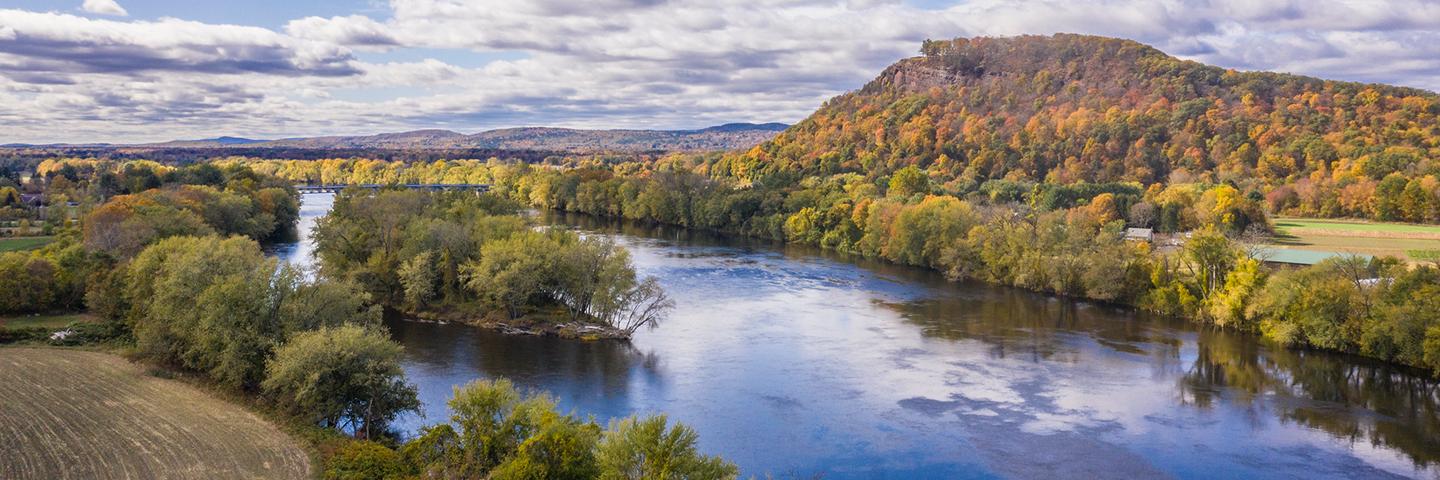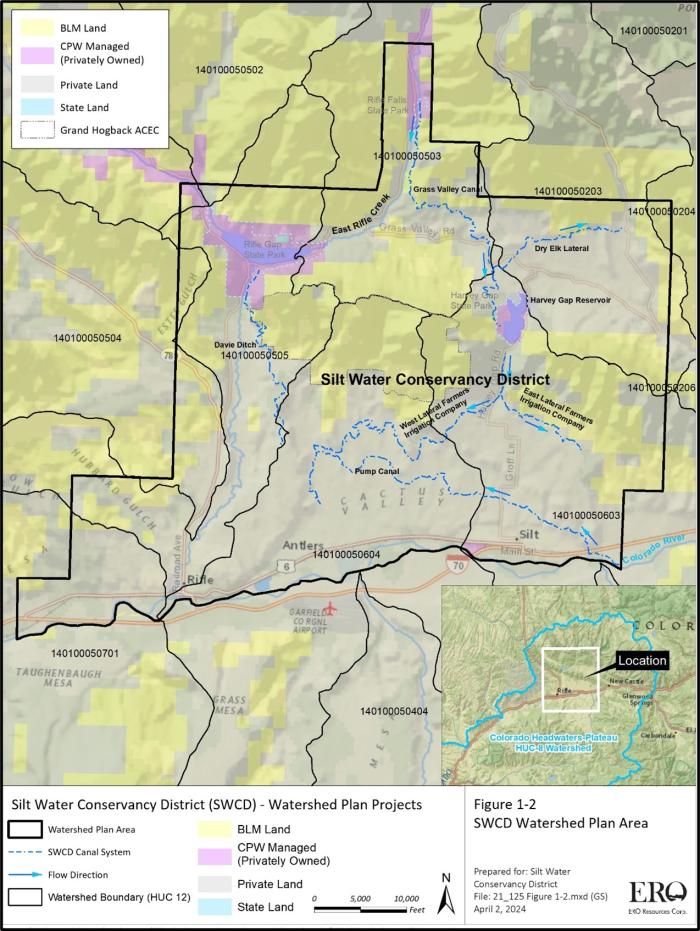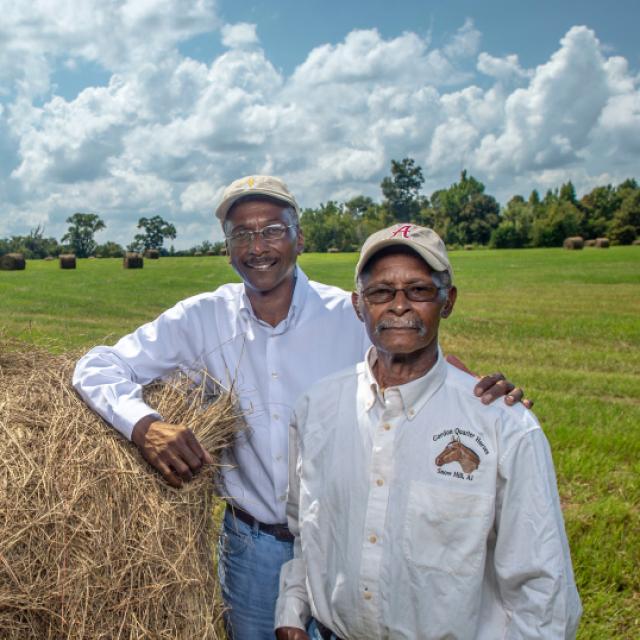
SILT WATER CONSERVANCY DISTRICT WATERSHED PROJECT
Year Awarded: Fiscal Year 2020
Colorado Counties: Garfield
Lead Federal Agency: U.S. Department of Agriculture - Natural Resources Conservation Service
Cooperating Agencies
Colorado Parks and Wildlife
U.S. Army Corps of Engineers
U.S. Department of the Interior - Bureau of Land Management
U.S. Department of the Interior - Bureau of Reclamation
U.S. Department of the Interior - Fish and Wildlife Service
Sponsor: Silt Water Conservancy District (SWCD)
Project Description
The U.S. Department of Agriculture Natural Resources Conservation Service (NRCS), with the project sponsor, the Silt Water Conservancy District (SWCD), is proposing to partially fund through the Watershed Protection and Flood Prevention Act (Public Law [P.L.] 83-566), the Silt Water Conservancy District Watershed Project (Project) in Garfield County, Colorado.
The purpose of the SWCD Watershed Project is to mitigate system failure, increase water availability, and attenuate the effects of drought on agricultural lands, protecting and enhancing the recreation and agricultural economy within the SWCD administrative boundaries in the Upper Colorado River watershed. The project would replace the Grass Valley Canal (GVC) flow control gate near the headgate along East Rifle Creek, shore up high-risk rock tunnel inlet/outlet areas downstream of the headgate, pipe four high-risk areas of the GVC downstream of the tunnels and reconstruct an abandoned section of the GVC near Harvey Gap Reservoir. The plan also proposes construction of a new pipeline between the Silt Pump Canal and the Farmers Irrigation Company East Lateral, which will facilitate use of about 1,300 more acre-feet (AF) of water each year that is stored 70 miles away in Green Mountain Reservoir and is currently unavailable. The SWCD project installation cost is estimated to be $4,921,000, of which $1,075,000 would be paid by the sponsoring local organization and other funding sources. The estimated amount to be paid through Federal NRCS P.L. 83-566 funds is $3,846,000.
Project Location Map

NEPA Analysis
As the lead federal agency, NRCS has completed National Environmental Policy Act (NEPA) analysis in the form of a Watershed Plan and Environmental Assessment (Plan-EA) to analyze impacts to the environment from this project. The Plan-EA complies with federal regulations that require an evaluation of potential environmental impacts associated with federal projects and actions.
A formal public review of the Draft Plan-EA occurred from December 4, 2024, to January 10, 2025. NRCS signed a Finding of No Significant Impact (FONSI) on July 3, 2025.
Current Status
The project planning phase has been completed. The FONSI and the final Plan-EA (with appendices) can be viewed or downloaded from the “Project Documentation” links provided below.
A request for Project Authorization has been submitted for consideration to the Chief of the NRCS.
Project Documentation
Contact Information
For further project information, please contact:
Blongshia Lindsay
USDA-NRCS-Colorado State Office
Post Office Box 25426
Denver, CO 80225-0426
Phone: 719-600-4710
Email: blongshia.lindsay@usda.gov
WFPO Resources
Watershed and Flood Prevention Act
Program governance - Public Law 83-566
Success Stories
Discover the incredible work WFPO performs across the nation
National Water Management Center
Bringing the landscape together: Local community goals and watershed scale planning solutions. The National Water Management Center (NWMC), located in Little Rock, Arkansas, serves as a focal point for water resources information exchange.
Learn MoreReady to get started?
Contact your local service center to start your application.
How to Get Assistance
Do you farm or ranch and want to make improvements to the land that you own or lease?
Natural Resources Conservation Service offers technical and financial assistance to help farmers, ranchers and forest landowners.

To get started with NRCS, we recommend you stop by your local NRCS field office. We’ll discuss your vision for your land.
NRCS provides landowners with free technical assistance, or advice, for their land. Common technical assistance includes: resource assessment, practice design and resource monitoring. Your conservation planner will help you determine if financial assistance is right for you.
We’ll walk you through the application process. To get started on applying for financial assistance, we’ll work with you:
- To fill out an AD 1026, which ensures a conservation plan is in place before lands with highly erodible soils are farmed. It also ensures that identified wetland areas are protected.
- To meet other eligibility certifications.
Once complete, we’ll work with you on the application, or CPA 1200.
Applications for most programs are accepted on a continuous basis, but they’re considered for funding in different ranking periods. Be sure to ask your local NRCS district conservationist about the deadline for the ranking period to ensure you turn in your application in time.
As part of the application process, we’ll check to see if you are eligible. To do this, you’ll need to bring:
- An official tax ID (Social Security number or an employer ID)
- A property deed or lease agreement to show you have control of the property; and
- A farm number.
If you don’t have a farm number, you can get one from USDA’s Farm Service Agency. Typically, the local FSA office is located in the same building as the local NRCS office. You only need a farm number if you’re interested in financial assistance.
NRCS will take a look at the applications and rank them according to local resource concerns, the amount of conservation benefits the work will provide and the needs of applicants. View Application Ranking Dates by State.
If you’re selected, you can choose whether to sign the contract for the work to be done.
Once you sign the contract, you’ll be provided standards and specifications for completing the practice or practices, and then you will have a specified amount of time to implement. Once the work is implemented and inspected, you’ll be paid the rate of compensation for the work if it meets NRCS standards and specifications.

